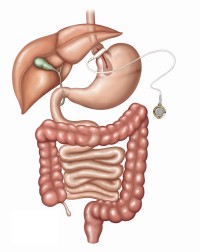Laparoscopic Adjustable Gastric Band
A silicone band is placed around the top of the stomach forming a small pouch and a small opening for food to pass through. This pouch will restrict the amount of food one is able to eat. The band is adjusted through the injection of saline water into a port placed below the skin in the abdomen. Multiple adjustments must be made in the office throughout the first year. Weight loss, averaging one to two pounds per week, is slower than the gastric bypass because it takes some time to adjust the band to the correct level for each person.
The patient must be motivated and compliant as this procedure will not prohibit problem foods high in sugar. The laparoscopic adjustable gastric band may be chosen because it is a lower risk, non-permanent procedure. Patients may not choose the laparoscopic adjustable gastric band if they do not want to go through the needle adjustments or have a foreign object in their body, and because of the slower weight loss.










